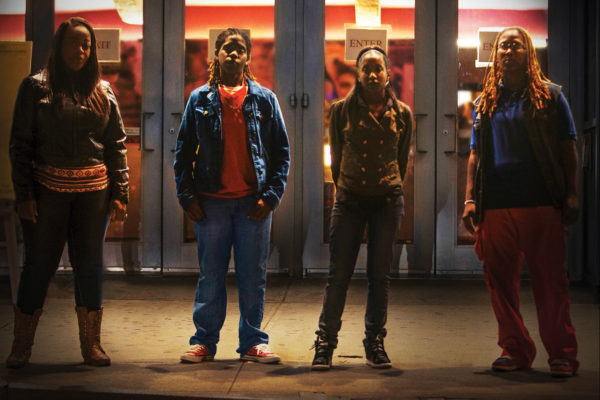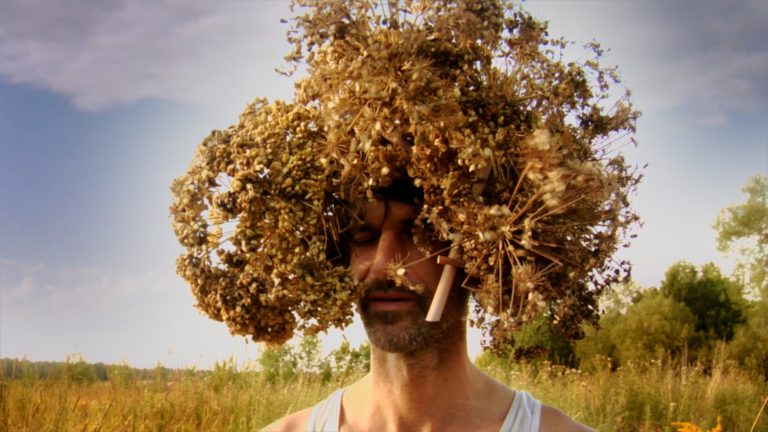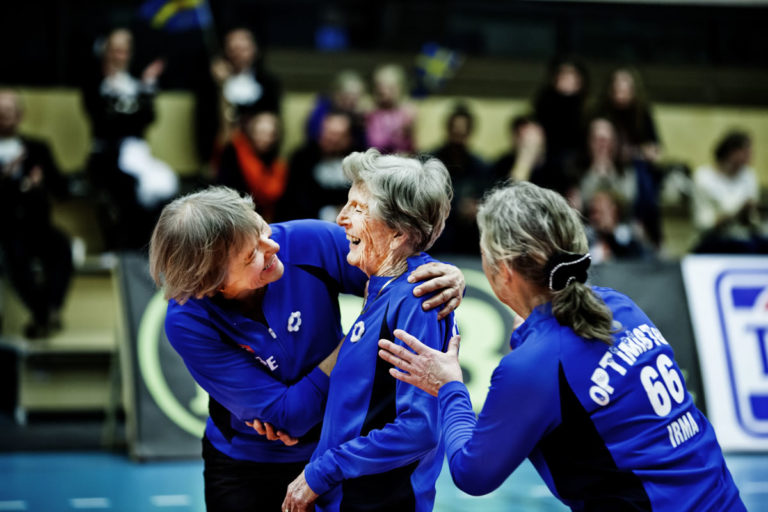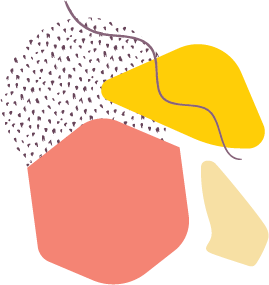Out in the Night is a documentary that tells the story of a group of young friends, African American lesbians who are out, one hot August night in 2006, in the gay friendly neighborhood of New York City. They are all in their late teens and early twenties and come from a low-income neighborhood in Newark, New Jersey. Two of the women are the focus – gender non-conforming Renata Hill, a single mother with a soft heart and keen sense of humor, and petite femme Patreese Johnson, a shy and tender poet. As they and their friends walk under the hot neon lights of tattoo parlors in the West Village, an older man sexually and violently confronts them. He says to Patreese “let me get some of that” as he points below her waist. When she says that they are gay, the man becomes violent and threatens to “fuck them straight”. He spits and throws a lit cigarette. Renata and Venice defend the group and a fight begins, captured by security cameras nearby. The man yanks out hair from Venice’s head and chokes Renata. Then, Patreese pulls a knife from her purse and swings at him. Strangers jump in to defend the women and the fight escalates. As the fight comes to an end, all get up and walk away. But 911has been called and the man involved has been stabbed. Police swarm to the scene as their radios blast out warning of a gang attack. The women are rounded up and charged with gang assault, assault and attempted murder. Three of the women plead guilty. But Renata, Patreese, Venice and friend Terrain claim their innocence. They are called a “Gang of Killer Lesbians” by the media. In activist circles they become known as The New Jersey 4.
Summary info for schedule – will be hidden on film page

Out In The Night
75-minutes
Screening day / time
Out In The Night
Filmmaker(s)
Running Time
Out In The Night
Filmmaker Notes:
Immediately following the arrest of seven young African American women on August 18th, 2006, I became interested in their case. I read the many salacious headlines like “Attack of the Killer Lesbians,” “Gal Gang,” “I’m a man, lesbian growled” and on and on. However, it was the first of many New York Times articles that really gave me pause. The headline read: “Man is stabbed after admiring a stranger.” An admirer?? I really could not believe it. A man does not ‘admire’ teenage girls on the street at midnight. That is harassment. And I have never met a woman who hasn’t been harassed on the street at some point in her life, never mind in New York City where it is commonplace.
A blog started as a community space for people to discuss what was happening in these headlines and news articles. There was a community meeting in the West Village at the LGBT Center in New York City that I attended. The conversation wasn’t about what happened that night, as it was so early and nobody knew the details, but people were focused on how you can protect yourself and your friends when you are threatened, who feels comfortable calling the police, and how to combat media bias.
I wanted to understand why this man was considered, in the mainstream news media, as a potential suitor and not a threat. Why weren’t these women seen as survivors of violent, homophobic harassment? And why were a group of friends with no criminal records, who were not a gang, being charged as a gang?
I believe this story would have unfolded differently had the women and gender non-conforming youth involved been white. Race and class, as well as gender and sexuality, were and remain critical issues in this case.
For the next two years I worked as a part-time activist around this case. Early on, the idea of a documentary was raised. A film collective of sorts was formed. At that moment, I was the only one in the group with a filmmaking background, but there was no part of me that wanted to direct this film. I did not think a white director should tell this story.
Two years later, however, as their appeals were approaching, I could not stop thinking about this story. I wrote to each of the women in prison and asked if I could come visit them and discuss the possibility of a documentary. I spoke with their family members to see if they were also interested. Immediately, the women were interested, but I wasn’t totally sure they knew what a documentary feature would entail. In retrospect, neither did I. So, I continued to visit them. I wanted to make sure we were able to get to know each other. If they weren’t going to feel comfortable with me, then I wasn’t going to make the film. I also began speaking with their appellate lawyers to get a better handle on the case.
As the women and I developed a relationship and I was beginning to understand the intricacies of the case and the appeals, I was also mapping out how to tell this story. Within a few months of deciding to make this film, Renata and Terrain, two of the four women, came home from prison. It is then that we really began to get to know each other. On the day of the first interview with them, Terrain and I were running out to get lunch, leaving my director of photography, Daniel Patterson and Renata at Terrain’s house. Renata became nervous immediately. She said she didn’t want to be left there with a “strange dude.” In that moment I realized how she is impacted by tremendous trauma from sexual violence and violent actions against her by men – in her childhood and into the night of the fight. It made me better understand her reaction on the night of the fight. I asked her to sit behind the camera and interview Daniel to get to know him before we began our interviews. They became close after that day. And later, she joked about what she might wear to her next interview to shock me: a dildo on the outside of her clothes.
Since the first interviews, I have written dozens and dozens and dozens of grants. And I do not know how many times I was turned down from a potential funder citing that these women weren’t believable because they laughed too much or didn’t cry on camera. When I would get these responses, I always thought back to this first day of interviews. If they only understood the fears that were hidden behind their humor and confidence. It informed my choices on how to express their personalities, from the screen to the hearts of audiences.
The best day of shooting happened on the day we were scheduled to fly to California with Terrain’s mother, Kimma, who was speaking with Angela Davis about her daughter’s incarceration. We got a call that Terrain was going to be released. So, instead of going to the airport, Kimma, my cinematographer, and I immediately began driving from Newark to Albion Correctional Facility. Albion is eight hours away, just south of the Canadian border. We spent the night in a nearby motel and at sunrise we began waiting in the Correctional Facility lot. We waited for five hours, as they had misplaced her release paper work. After hours (and actually years) of waiting, Terrain was released and her charges dismissed. It is a weird feeling, a prison release. You cry and hug and laugh, but then you quickly get the hell out of there because you want to be as far away from the prison as possible. We drove the eight hours back to New Jersey, arriving home around midnight. At 4:00 a.m. we were all on our way to the airport to fly to California for the talk with Angela Davis. A few hours after landing, Kimma, Terrain and Angela were speaking to a room full of supporters. It was about the coolest thing I could ever imagine.
I think one of the reasons this story feels so important to me is all the gray areas that it covers, including the interesectionality of their identities and oppressing forces. These young friends, being black, conjured up stereotypes of what a ‘gang’ looks like. The gang assault charge must be re-examined as it is ill-defined and disproportionately used against youth of color, as we see in this story. This is also where gender identity stereotypes become so powerfully oppressive. Most of the images used to discuss this case were of Terrain. Terrain could potentially pass as male. So, when using her photo with the headline “Gang” – it maintained this image. Even now, of the seven women she is the only one without a felony on her record, and after her charges were dismissed, her picture continued to be used. These images and mis-quotes in headlines like “I’m a man, lesbian growled” were used to deny that they were women. Women using physical force to fight back has never been socially acceptable.
Even though it didn’t really make it into the film as strongly as I had once hoped, each of the women have a great sense of gender identity. Way too often in the mainstream, LGBT rights are spoken about through ‘marriage equality.’ Gender identity blends with ‘sexuality’ as if they are one in the same. But their gender identities played a role in this story, particularly in the way they were represented in the media. Terrain and Renata identify as AG or Aggressive, meaning a masculine identified woman (as a general oversimplification). Venice and Patreese identify as Femme. In an interview which did not make it into the film, Venice says “An AG is someone who is comfortable in their skin.”
So as we move beyond marriage equality as the central LGBT issue, their experiences reveal so many more that need to be addressed: Feeling safe on the street. In any town, in any city. The right to defend yourself without fear of imprisonment. Trust in calling the police when you are threatened. And representations of spectrums of gender that aren’t neatly “male” or “female.”
I deeply believe that arguing for self-defense does not work for the very people it should be used to protect. In order to find that someone rightfully acted in self-defense, their histories with past traumas need to be included in the courtroom with full weight given to them. I want people to understand how PTSD from sexual trauma impacts how a person responds to a sexually violent threat. I want people to understand that Renata was never given the full care and support she needed as a child survivor of sexual abuse and torture. Why was Renata’s rapist, who sexually assaulted her from the age of 9 to 16 years old, given less time in prison than she received for defending herself. The man who threatened her that night said he would ‘fuck her straight.’ In her eyes, he said that he would rape her.
I want discussions to go deeper. This case is not cut and dry, as the women defended themselves with force. It is messy and complicated. We need to be prepared to talk about the gray areas.
Some of the greatest challenges for me while shooting were filming vérité; it felt voyeuristic. I didn’t like the feeling of raising money for a shoot when that shoot would be an interview with a mother living in a homeless shelter. I didn’t like waiting quietly for someone to be released from prison. I wanted to put the camera down and yell. Mostly, my challenge has been to find that almost-impossible balance of filmmaker / advocate / activist. Being a documentary storyteller sometimes means calming your sense of moral outrage and fury at injustice so that you do press ‘record’.
My approach to filmmaking is both political and practical. I very much identify as an Anarchist. Oddly, the act of making an independent film feels like the truest way for me to live that out in my career. When it works correctly, filmmaking is about a small, passionate and dedicated group of people governing equally. We work equally in our specific roles for a common and shared vision. I love that part of filmmaking. I’m sure many people wouldn’t necessarily agree with me, but for me it is the lens through which I see and feel the process.
As a developing artist, I originally found my creative voice in the abstraction of painting and sculpture. But I did not continue in fine arts because of that very abstraction. I want access to meaning and justice to be more transparent. In my ‘other’ life, in social services and activism, I’ve paid attention to those things. So, filmmaking -visual storytelling – merges these two parts of me in a way that feels whole.




